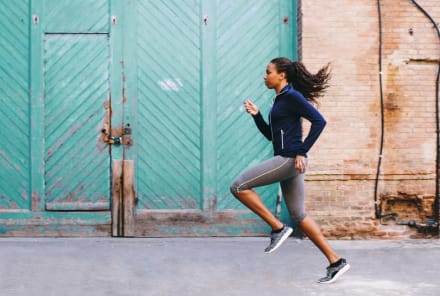Advertisement

You can tell a lot about someone's movement patterns by their posture, and all solid posture starts with spinal alignment. Spinal alignment might not be the sexiest subject, but it is the core of our being. When we find our optimal structural alignment, we have a greater ability for freedom of movement and better muscular engagement. "Neutral spine" is the most direct route to spinal alignment, when the S-curve of the spine is in alignment (read: good posture).
Concentrating on the spine in flexibility, stability, and strength is the basis of our mission at The Dailey Method. It is always our first alignment principle and at the root of every exercise we teach. Ahead, how to find your specific alignment, as well as four exercises that help you maintain neutral spine and move through the world with greater ease.
There are three components involved in finding your ultimate alignment:
1. Space.
Breathe as much space as possible from head to toe, head to tailbone—based on your position. This creates an ease in your structure. Creating space also helps encourage disc health. It helps the bones to be able to settle into the joints most optimally.
2. Find your neutral.
This is the healthiest position for our bodies. Focusing on moving through life in this postural awareness is crucial, as it translates directly to all facets of our lives. Three curvatures make up your spine: Cervical curves inward, thoracic curves posteriorly, and lumbar inward.
3. Support.
This is the act of keeping the space, maintaining the alignment, hugging inward, and engaging muscular support for that optimal position. It's an energy that originates from the inside out and is a supportive and easeful balance that ultimately results in a person being able to hold neutral spine with more ease.
How to achieve a neutral spine (NS) for an optimal seated position.
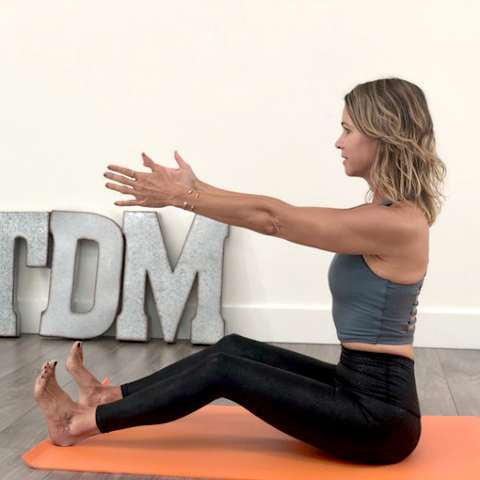
I call this a meditation on posture. During this pose, we'll find your optimal alignment, where it is today, and focus on your breath to guide you to find deeper engagement and support for that alignment.
- Sit with your legs in front of you, hip distance apart, slightly bent. Widen your sitz bones so that your thighs are sitting deep in your hip sockets.
- Root your sitz bones downward and reach oppositional energy up through the crown of your head, creating as much length in your spine as possible.
- Breathe your ribs and your jawline back so that you have the plumb torso alignment of ears over shoulders, over ribs, over hips. In profile, you'll see the three curvatures of your spine.
- Focus on your breath. As you inhale, try to create more length. As you exhale, hug muscle to bone and engage a corset effect around your lengthened spine.
- Repeat several times.
Turned-out squat for core and knee-joint strength.
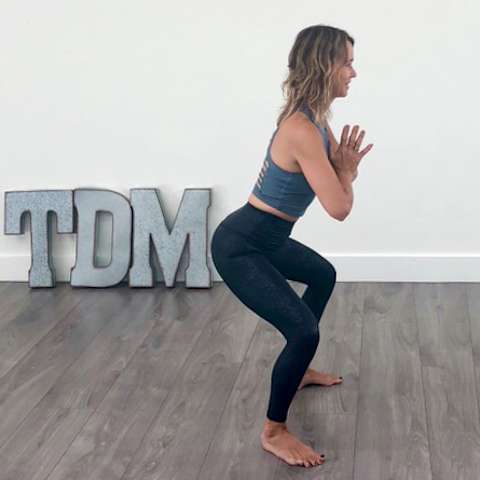
Turned-out squat is a functional exercise that trains your body to bend and lift in its most supported state. This translates in so many practical ways to our everyday activities. Turned-out squat is also an exercise that provides you with the tremendous benefit of strengthening your knee joints. This can help offset or rehabilitate knee problems, especially the more common ones that are medial or lateral to the joint.
Always prioritize alignment and active muscular engagement over depth and range of motion. Because all of our pelvis and thigh bone integrations are different, your neighbor may squat lower, but you're both doing what's ideal for your own body type.
- Take your feet slightly wider than your hips and turn your toes out to 2 and 10 o’clock.
- Feel your weight distributed evenly through all four corners of your feet, bend your knees as deeply as you can. Your knees will come forward of your ankle joint but must stay behind your toes and be centered with your feet.
- Lift your torso as upright as you can, maintaining neutral spine. It will be a parallel angle with your shins, but the more you focus on lifting your torso upright, the more capacity you have to engage core musculature.
- Extend your legs. As you extend, focus on the energy of pressing upright from your gluteals and the energy of dragging your heels behind you to engage your hamstrings.
- On the lowering position, envision the elongation of your quadriceps. This will keep them engaged muscularly all around the knee joint and encourage a longer, stronger muscle.
- Bend your knees; keeping them aligned over the centerline of the foot gives you the support of both the inner thighs and the outer thighs. Pay attention to hugging your inner shins toward each other while pressing your inner thighs away from each other at the same time throughout the bending and lengthening. This action is referred to as "shins in, thighs out" and helps you maintain engagement of both inner and outer thighs so you're hugging muscle to bone and optimizing stability and power—front to back, side to side.
- Squat and inch up an inch 30 times and then hold for 20 seconds.
Flat back on the floor for length.
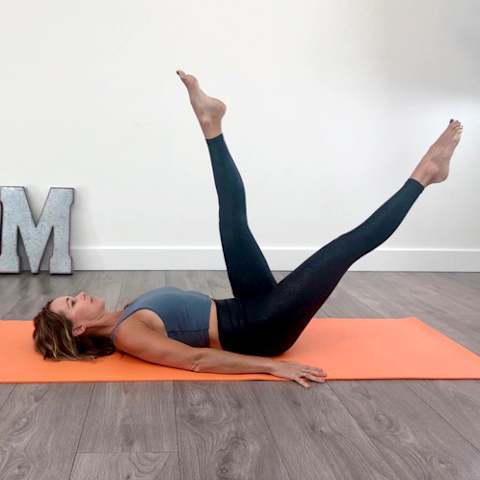
We teach this exercise with a neutral spine and pelvis while trying to find axial elongation. Axial elongation is the proper alignment of the head, spine, and pelvis, with as much length as possible, providing optimum spacing between the joints during movement. When you are in alignment, you have a better capacity to engage your muscles properly. Alignment of your spine is the key to getting the best benefit out of every exercise.
The focus of this exercise is back-body integration into the ground. By energetically connecting your entire back-body to the floor, you have greater ability to fire up all of your trunk stabilizers.
- Lie on your back with knees bent and feet flat on the floor. Rock your pelvis back and forth (toward your head and away from your head) to find the middle point, which will be your neutral.
- Inhale length to your spine and try to reach sitz bones and the crown of your head as far away from each other as possible. This is what is defined above as axial elongation. You're actively creating more space between each of your pairs of vertebrae while maintaining optimal alignment.
- Press the energy of your back to the ground without changing the position. Feel your sacrum root down, your rib cage and shoulder blades press down, and the sides of your waist connecting into the floor. Your low back will likely still be slightly off of the floor, but you are energizing the musculature of your entire back downward. By activating the muscles of the back-body, you create a corset of support. You'll notice that the action of pressing down with the back-body will naturally create a deeper engagement of the abdominal muscles.
- Maintain stability, lift your legs up, and straighten them out over your hips. (If you have tight hamstrings, keep the legs slightly bent.)
- Lower one leg toward the floor as far as you can without losing alignment or engagement, and then alternate.
- Do this 15 times on each leg.
Upright lunge for neutral spine and glute strengthening.
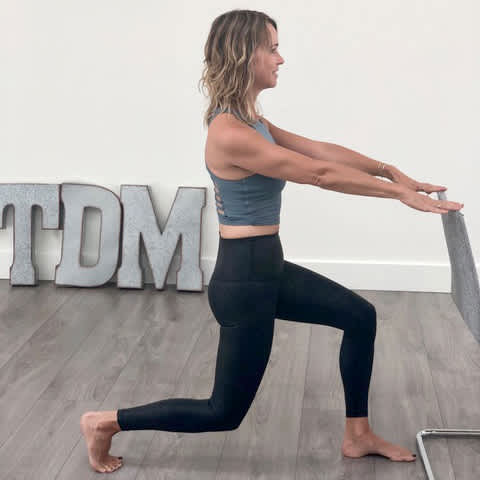
This is a great exercise to find neutral spine and to get some great gluteal work in, too! Your gluteals are the base of where your spine sits. Having strong supportive gluteal muscles translates to your overall spinal health.
- Hold on to a high surface, like a countertop, and lunge one leg forward and the opposite behind you. Your front knee lines up directly over your ankle, your back knee directly under your hips, and both knee joints are at right angles. Keep your front thigh parallel to the floor.
- Draw the outer edge of your front hip back to square your hips forward.
- Keep your arms straight and torso upright. Breathe your ribs and jawline back to find the natural cervical, neck, and thoracic/upper back curvatures of your spine. Then hug inward to support this alignment.
- Keep your torso stabilized in this position. Bend your back knee closer to the ground, and then lift up a few inches. As you lower, think of lengthening the front quadriceps and your spine. As you lift, drag the front heel energy backward to ignite the base of your seat.
- Do this 50 times on each side.
Whether you're exercising, carrying groceries, or playing with children, finding optimal alignment of your spine and maintaining that alignment through your movements will enable you to move more freely, confidently, and energetically through your life.
Watch Next
Enjoy some of our favorite clips from classes
Enjoy some of our favorite clips from classes
What Is Meditation?
Mindfulness/Spirituality | Light Watkins
Box Breathing
Mindfulness/Spirituality | Gwen Dittmar
What Breathwork Can Address
Mindfulness/Spirituality | Gwen Dittmar
The 8 Limbs of Yoga - What is Asana?
Yoga | Caley Alyssa
Two Standing Postures to Open Up Tight Hips
Yoga | Caley Alyssa
How Plants Can Optimize Athletic Performance
Nutrition | Rich Roll
What to Eat Before a Workout
Nutrition | Rich Roll
How Ayurveda Helps Us Navigate Modern Life
Nutrition | Sahara Rose
Messages About Love & Relationships
Love & Relationships | Esther Perel
Love Languages
Love & Relationships | Esther Perel



